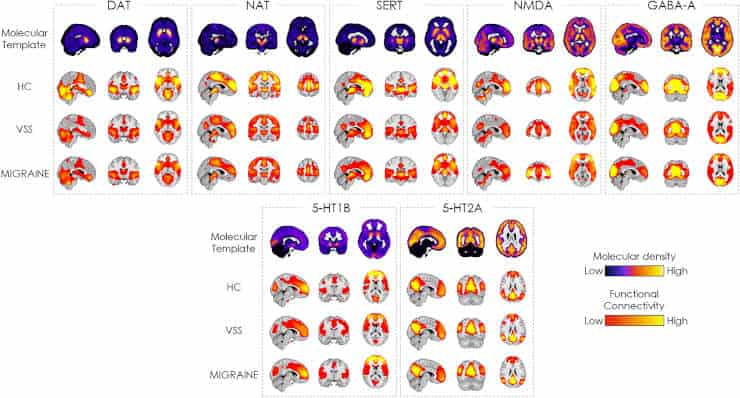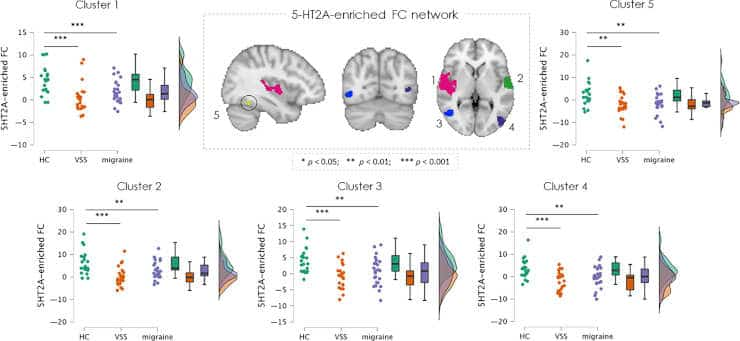In people with visual snow syndrome, the patterns of activity in two brain chemical systems, glutamate and serotonin, differ from those in people without the condition, researchers from the Institute of Psychiatry, Psychology & Neuroscience (IoPPN) at King’s College London have shown.
The researchers used previously collected scanning data from 24 patients with visual snow syndrome (VSS), 25 migraine patients, and 24 healthy people with no history of VSS or migraine. The brain scans were performed at the National Institute of Health’s King’s Clinical Research Facility.
Visual snow syndrome is a continuous visual disturbance in which people see flickering dots, static, and flashing lights while their eyes are open and closed. It affects approximately 2–3% of the global population and can be debilitating, affecting vision, hearing, sensory processing, thinking, and quality of life.
Visual Snow Syndrome A Neurological Disorder

Credit: Ann Neurol. 10.1002/ana.26745 CC-BY
Currently, there is no effective medication for people with visual snow syndrome, and the search for a treatment has been hampered by a lack of understanding of the condition’s underlying biology.
Earlier scanning studies in people with VSS have shown alterations in different regions of the brain and how these interact, but no research has looked into the possible molecular changes that could underpin the condition. Further research in this area could reveal potential biological targets for treatment.
“Previous research has given us some insight into the brain regions involved in visual snow syndrome but our study is the first to identify the brain chemistry that could underlie the condition and other sensory experiences such as migraine aura. Until now there have been no effective treatments for VSS and importantly our research has confirmed that VSS is a neurological disorder with a chemical basis that could be used as a target for development of treatments,”
said Dr. Francesca Puledda, first author of the study.
Receptor-Enriched Analysis of Functional Connectivity by Targets
The study combines information from PET imaging on the distribution of different chemical receptors in the brain with functional Magnetic Resonance Imaging (fMRI) analysis of the interaction of activity between different regions of the brain, which was developed by researchers at the NIHR Maudsley BRC.
Researchers can create a map of brain chemical activity across different brain areas using this Receptor-Enriched Analysis of Functional Connectivity by Targets (REACT) approach. This study looked at five brain chemicals: noradrenaline, dopamine, serotonin, glutamate, and GABA.

Credit: Ann Neurol. 10.1002/ana.26745 CC-BY
Researchers discovered specific differences in the activity of glutamate and serotonin networks in specific areas of the brain in patients with VSS.
When compared to healthy controls and migraine patients, those with visual snow syndrome had less synchronized activity (or functional connectivity) in glutamate networks in the anterior cingulate cortex (ACC). The ACC is a hub for thinking and top-down control over sensory inputs, and the different patterns of activity could represent an interruption in visual information filtering and integration.
Linked To Migraine Aura?
In addition, compared to healthy controls, VSS patients had lower functional connectivity in serotonin networks of the visual cortex, insula, temporal pole, and orbitofrontal areas of the brain.
This decreased connectivity in serotonin networks was also observed in migraine patients who had aura, implying a biological link between VSS and aura. According to the findings, serotonin activity in visual snow syndrome patients may influence the integration of complex sensory information.
The findings revealed no differences for the other brain chemicals studied in the research.
Participants in the study had to be between the ages of 20 and 60, with no contraindications to undergoing an MRI, not consuming more than 6 cups of coffee per day, no serious previous medical conditions, no history of any recreational drug intake in the past, not taking any medication acting on the central nervous system, and no psychological issues that would require medication or that could affect neural pathways.
The study’s main limitation is its small sample size, which could have influenced the final results. Furthermore, despite the fact that the imaging parameters and study location were identical, the migraine cohort was added later for analysis purposes and thus was not included in the original study.
Reference:
- Puledda, F., Dipasquale, O., Gooddy, B.J.M., Karsan, N., Bose, R., Mehta, M.A., Williams, S.C.R. and Goadsby, P.J., Abnormal Glutamatergic and Serotonergic Connectivity in Visual Snow Syndrome and Migraine with Aura. Ann Neurol. 10.1002/ana.26745. 19 Jul. 2023, doi:10.1002/ana.26745
Last Updated on September 19, 2023
